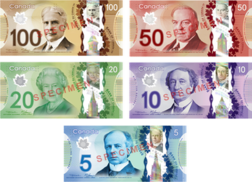Canada dollar
| Canadian dollar | |
|---|---|
|
Canadian dollar (English) dollar canadien (French) |
|

|
|
| ISO 4217 | |
| Code | CAD |
| Number | 124 |
| Exponent | 2 |
| Denominations | |
| Subunit | |
| 1/100 | Cent (English) and sou (colloquial) (French) |
| Symbol | $ or Can$ or C$ or CAD |
| Cent (English) and sou (colloquial) (French) | ¢ |
| Nickname |
Loonie, buck (English) Huard, piastre (pronounced piasse in popular usage) (French) |
| Banknotes | |
| Freq. used | $5, $10, $20, $50 |
| Rarely used | $100 |
| Coins | |
| Freq. used | 5¢, 10¢, 25¢, $1, $2 |
| Rarely used | 50¢ |
| Demographics | |
| Official user(s) |
|
| Unofficial user(s) |
|
| Issuance | |
| Central bank | Bank of Canada |
| Website | www |
| Printer | Canadian Bank Note Company |
| Mint | Royal Canadian Mint |
| Website | www |
| Valuation | |
| Inflation | 1.06% (2015) |
| Source | Statistics Canada, 2012. |
The Canadian dollar (symbol: $; code: CAD) (French: Dollar canadien) is the currency of Canada. It is abbreviated with the dollar sign $, or sometimes Can$ or C$ to distinguish it from other dollar-denominated currencies. It is divided into 100 cents.
Owing to the image of a loon on the one-dollar coin, the currency is sometimes referred to as the loonie by foreign exchange traders and analysts, as it is by Canadians in general, or huard in French.
Canada's dollar is the fifth most held reserve currency in the world, accounting for approximately 2% of all global reserves, behind only the U.S. dollar, the euro, the yen and the pound sterling. The Canadian dollar is popular with central banks because of Canada's relative economic soundness, the Canadian government's strong sovereign position, and the stability of the country's legal and political systems.
In 1841, the Province of Canada adopted a new system based on the Halifax rating. The new Canadian pound was equal to four US dollars (92.88 grains gold), making one pound sterling equal to 1 pound, 4 shillings, and 4 pence Canadian. Thus, the new Canadian pound was worth 16 shillings and 5.3 pence sterling.
...
Wikipedia
